|
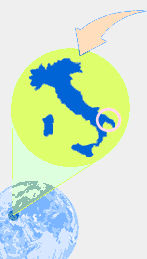
A fable of
4000 years
 Ceglie
Messapica, one of the most ancient centres in Puglia, marks
the hilly border of the Murge highlands to the South-East,
opening its natural terrace to the Salento and the surrounding
Brindisi plain. Three hundreed metres above sea-level, Ceglie
Messapica is inhabited by little more than 21.000 inhabitans,
described stubborn but very hospitable by the Ottocento century
travellers,who,therefore, appreciated its nature and its not
always proper plain-speakimg. Its dialet is from
Japigio group of languages, hard, apocapated, sing-song, with
its open and extensible vowels; nothing in common with ritmato,
mieloso leccese fom a certain Hellenic origin. Probably the
genesis of the Cegliese phoneme, yet with the mixture of the
centuries, is to be found in the nearest Balkanic countries
("A-cci simin’ akkogghj’ ", He thet sows, mows).
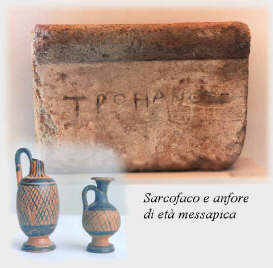 The
history of Ceglie Messapica goes back to at least 15 centuries
before Christ, its origin is surely preHellenic, but traces and
new finds, under consideration to-day, might date back to 4.000
years ago. At present Pelasgi and Cretesi are rivals for the
birth certificate of the city; they made ancient Kailia to be an
important military and commercial centre of the Messapi, the
people who settled between the Adriatic and Ionian seas.
Afterward the history of Ceglie absorbs the Latin and Roman rule,
the decadance of the august Empire and the coming of the
Communes. After the Midde Age period that deeply marked the
culture and behaviors of Meridione (South Italy), Renaissance
reveals here, too, with its renewed political system protecting
aristocracy of the time and encouraging arts and cultural
exchanges: between 16 The
history of Ceglie Messapica goes back to at least 15 centuries
before Christ, its origin is surely preHellenic, but traces and
new finds, under consideration to-day, might date back to 4.000
years ago. At present Pelasgi and Cretesi are rivals for the
birth certificate of the city; they made ancient Kailia to be an
important military and commercial centre of the Messapi, the
people who settled between the Adriatic and Ionian seas.
Afterward the history of Ceglie absorbs the Latin and Roman rule,
the decadance of the august Empire and the coming of the
Communes. After the Midde Age period that deeply marked the
culture and behaviors of Meridione (South Italy), Renaissance
reveals here, too, with its renewed political system protecting
aristocracy of the time and encouraging arts and cultural
exchanges: between 16 th
and 18th century il
Castello ducale, la Chiesa Collegiata, the marvellous
baroque-style curch of San Domenico with the attached monastery,
at present Town Hall, are completed.
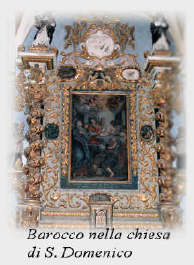 Since
the Ottocento century Ceglie has extended step by step the
limits of the town and just the excavation for the foundation of
new buildings allowed priceless archeological remains to come
out, being kept in the museum of Taranto, in the one of Berlino,
and in private collections of Italian and foreigners researchers.
Unfortunately a lot of remains, the only evidence of the past,
are lost. Since
the Ottocento century Ceglie has extended step by step the
limits of the town and just the excavation for the foundation of
new buildings allowed priceless archeological remains to come
out, being kept in the museum of Taranto, in the one of Berlino,
and in private collections of Italian and foreigners researchers.
Unfortunately a lot of remains, the only evidence of the past,
are lost.
At present, the city is pursuing a new social
and economic identity. The post-industrial era with its
diminishing production of chemical pole of Brindisi and its iron
pole of Taranto is imposing new schemes of employment; still
among great difficulties, typical in the South, the services
sector aim
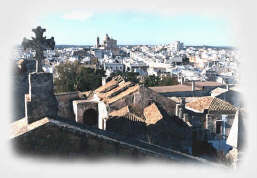 at
the capacity of aggregation, wich soon could change into small
industry, textile workshops thrive, meanwhile agriculture,
expecially the olive-one, remains one of the main source of
income, sometimes integrative. at
the capacity of aggregation, wich soon could change into small
industry, textile workshops thrive, meanwhile agriculture,
expecially the olive-one, remains one of the main source of
income, sometimes integrative.
Tourism is a phenomenon awaiting development,
fed mostly, by single private enterprise: some masserie (farmhouses)
and trulli (cone-shaped buildings) in the Cegliese
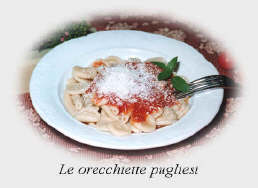 countryside
have been restored and included in the farm holiday-makers tours,
acting a strong pull in Germany, Great Britain and North Italy.
Cookery indeed is flourishing; the city and the country-side is
full of restaurant, known and appreciated even outside the
borders of Regione Puglia: so that the ancient chief-town of
Messapi for several years has become the capital of cookery of
the "people who lived between the two seas". countryside
have been restored and included in the farm holiday-makers tours,
acting a strong pull in Germany, Great Britain and North Italy.
Cookery indeed is flourishing; the city and the country-side is
full of restaurant, known and appreciated even outside the
borders of Regione Puglia: so that the ancient chief-town of
Messapi for several years has become the capital of cookery of
the "people who lived between the two seas".
Back
Anthology
of Ceglie Messapica
|


 The
history of Ceglie Messapica goes back to at least 15 centuries
before Christ, its origin is surely preHellenic, but traces and
new finds, under consideration to-day, might date back to 4.000
years ago. At present Pelasgi and Cretesi are rivals for the
birth certificate of the city; they made ancient Kailia to be an
important military and commercial centre of the Messapi, the
people who settled between the Adriatic and Ionian seas.
Afterward the history of Ceglie absorbs the Latin and Roman rule,
the decadance of the august Empire and the coming of the
Communes. After the Midde Age period that deeply marked the
culture and behaviors of Meridione (South Italy), Renaissance
reveals here, too, with its renewed political system protecting
aristocracy of the time and encouraging arts and cultural
exchanges: between 16
The
history of Ceglie Messapica goes back to at least 15 centuries
before Christ, its origin is surely preHellenic, but traces and
new finds, under consideration to-day, might date back to 4.000
years ago. At present Pelasgi and Cretesi are rivals for the
birth certificate of the city; they made ancient Kailia to be an
important military and commercial centre of the Messapi, the
people who settled between the Adriatic and Ionian seas.
Afterward the history of Ceglie absorbs the Latin and Roman rule,
the decadance of the august Empire and the coming of the
Communes. After the Midde Age period that deeply marked the
culture and behaviors of Meridione (South Italy), Renaissance
reveals here, too, with its renewed political system protecting
aristocracy of the time and encouraging arts and cultural
exchanges: between 16 Since
the Ottocento century Ceglie has extended step by step the
limits of the town and just the excavation for the foundation of
new buildings allowed priceless archeological remains to come
out, being kept in the museum of Taranto, in the one of Berlino,
and in private collections of Italian and foreigners researchers.
Unfortunately a lot of remains, the only evidence of the past,
are lost.
Since
the Ottocento century Ceglie has extended step by step the
limits of the town and just the excavation for the foundation of
new buildings allowed priceless archeological remains to come
out, being kept in the museum of Taranto, in the one of Berlino,
and in private collections of Italian and foreigners researchers.
Unfortunately a lot of remains, the only evidence of the past,
are lost. at
the capacity of aggregation, wich soon could change into small
industry, textile workshops thrive, meanwhile agriculture,
expecially the olive-one, remains one of the main source of
income, sometimes integrative.
at
the capacity of aggregation, wich soon could change into small
industry, textile workshops thrive, meanwhile agriculture,
expecially the olive-one, remains one of the main source of
income, sometimes integrative. countryside
have been restored and included in the farm holiday-makers tours,
acting a strong pull in Germany, Great Britain and North Italy.
Cookery indeed is flourishing; the city and the country-side is
full of restaurant, known and appreciated even outside the
borders of Regione Puglia: so that the ancient chief-town of
Messapi for several years has become the capital of cookery of
the "people who lived between the two seas".
countryside
have been restored and included in the farm holiday-makers tours,
acting a strong pull in Germany, Great Britain and North Italy.
Cookery indeed is flourishing; the city and the country-side is
full of restaurant, known and appreciated even outside the
borders of Regione Puglia: so that the ancient chief-town of
Messapi for several years has become the capital of cookery of
the "people who lived between the two seas".